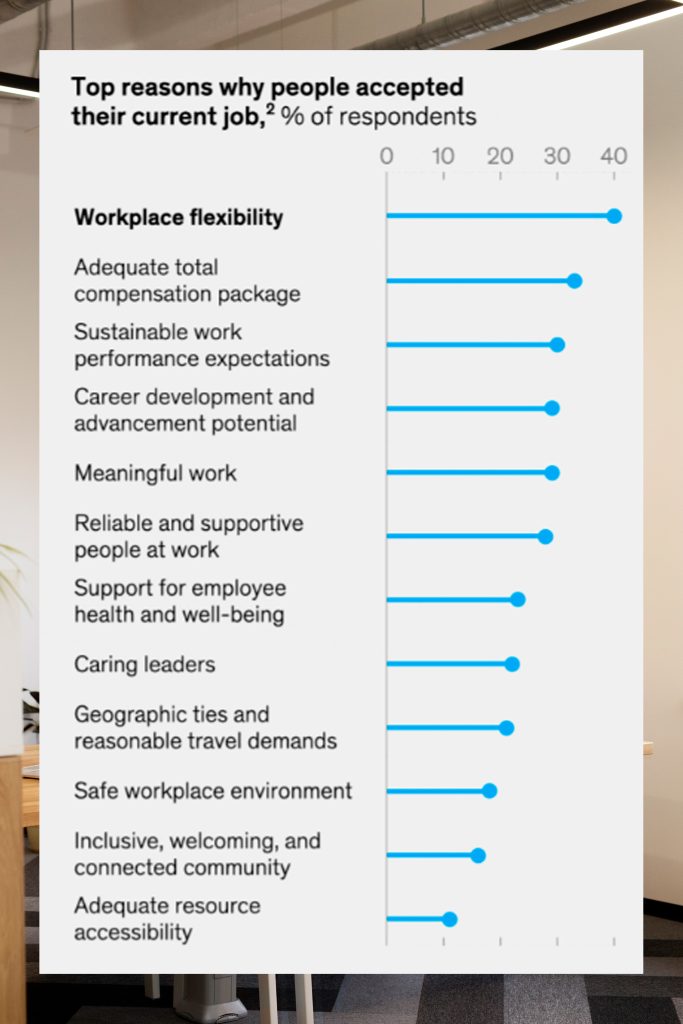The common denominator of the vast majority of new public companies with explosive growth over the last two decades has been their ability to take something that was difficult and make it simple. This simplification is often referred to as being “frictionless”.
Examples are Amazon, Netflix, Spotify, Paypal, Uber, and most of the other new brands that you can name.
The daily office attendance that we all accepted without much questioning historically has not been frictionless. It may have required a commute, getting ready, packing a lunch, visiting the dry cleaners, stopping for gas or a car wash, waiting for a bus or the subway, or navigating a parking garage.
It also generally forced everyone into a synchronous schedule (a/k/a rush hour), work type (group), and productivity preference (work from office). The routine and expectation lacked humanity. There was no consideration for:
- Schedule – eg. kids home at 4, must work until 5
- Commute – eg. distance and transportation mode
- Convenience – eg. consider the difficulties encountered by a person with a physical handicap as being toward the extreme
- Tasks – eg. consider the focus required by a computer coder or financial analyst, either of whom may not need to speak to another person for an entire day to complete their work
We’re now seeing the effects of work flexibility. Numerous studies show that companies that adopt flexible work are better than their competitors at attracting and retaining talent as employees have stated that they would seek other employment opportunities even at reduced pay if forced to regress to a pre-Covid work style. Check out this McKinsey & Company chart:

Employees value flexibility not only for the saved commute time but also because the flexibility allows for lifestyle improvements such as being able to drop off kids, hit the gym, or work in their pajamas with a cat on their lap. How much appreciation, loyalty, and productivity is created may still need to be evaluated however there is no denial that to some degree it exists.
It is the humanizing of workplace strategy that most executive teams seem to undervalue as “frictionless employment”.
The pushback, and disparity in perspective between employer and employee, is productivity. In various surveys, approximately 70% of employers claim that staff is less productive remotely. Approximately 70% of employees claim that they are more productive working remotely. Who is correct? They both are.
Staff are more productive on their individual tasks when they are able to work with no distractions, which apparently 70% of them are when working from home. Unfortunately, when remote, they are also much less effective at team objectives such as knowledge transfer, building relationships and trust, and creative collaboration.
Solving for optimum productivity in both individual tasks and team objectives by removing the friction from completing that work should be the goal of workplace policy. The way that work is completed will vary by job description.
While some staff’s primary responsibility is knowledge transfer, building relationships and trust, and creative collaboration, there are others for whom those are very insignificant portions of their responsibilities.
Requiring in-office attendance for knowledge workers two or three days per week as a blanket requirement is generally a poor strategy to balance staff productivity and satisfaction. It’s probably just right for some portion of your staff, and either more or less than needed for the rest. Why mandate, or even tolerate, this inefficiency?
To optimize both productivity and satisfaction, you need to assess each individual, their role on the team, and executive objectives. The benefits of this approach is the most frictionless employee experience AND the most productive use of staff time and resources. Make working for your firm as frictionless as possible.







